When it comes to home construction, the little things really do add up to ensure your indoor environment is a safe space. One often overlooked component of a home is the gutter system. These little hollow tubing systems help prevent any precipitation from making its way right into your homes. Or, at least, they're supposed to! If they’re improperly installed or maintained, water damage from gutters can turn your home into a health hazard.
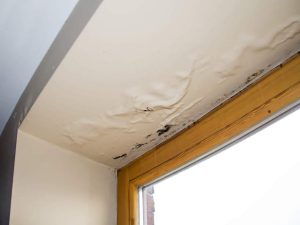
Unfortunately, this scenario happens far too often. Sure, most homeowners give their gutters a cursory glance every once in a while, but when is the last time you gave these water-channeling devices your full attention? Chances are, only when a problem develops that leads to issues like pooling water near the foundation of the home or roof damage.
No one wants to find themselves staring at a moisture mess in their home or the bill that comes along with it.
That’s why it’s important to understand what these devices are, how they should be properly installed, and the steps to maintaining them to prevent water damage from gutters from happening to your home.
Otherwise, any moisture-filled opportunities can not only cause structural damage, but also allow indoor contaminants like mold, mycotoxins, and bacteria to move into your indoor environment.
What Are Gutters?
Gutters are often the unrecognized heroes of home protection. While they’re not a top-notch indoor security system that beeps when anyone sneezes too close to a home, they do wage war on moisture from events such as rain and snow.
Their ability to transport water away from the home is thanks to their simple but effective design. The gutters themselves are essentially hollow metal tubing that has been cut in half so that the top portion is wide open and exposed not only to the sky but also to the roof. These channels sit perpendicular to the roof, or right against the edge of the surface.
The open shape, along with installing them at a slight angle, allows gutters to capture any precipitation and runoff from the roof and transport it to the downspout, which is also known as the leader. This vertical tubing slopes down the side of the home and gently transports any water away from the structure.
Are Gutters Necessary?
You may be thinking, what’s wrong with just allowing the roof to that job? Seems way simpler, right? That way, water damage from gutters will never occur.
While our roofs do an amazing job at protecting the interior of our homes from moisture, they can’t properly funnel the water away. Without gutters, water can pool in places like on the roof itself, around windows, basements, crawlspaces, and along the foundation of the building. Each of these situations can lead to structural damage and water entering the home.
To better put it into perspective, one inch of rain will create around 623 gallons of runoff from a 1,000-square-foot roof. Whether in an area with mild, moderate, or heavy precipitation, that amount of water can add up and cause serious damage to a home.
A gutter’s job is to channel all of that precipitation away from the roof to the ground level, and then safely away from the foundation of the home. That way, all of those gallons of water don’t pool where they should and start causing mayhem to your home.
How Does Water Damage From Gutters Happen?
While this tubing system is an amazing way to protect the home, they’re not foolproof. There are several ways that water damage from gutters can occur.
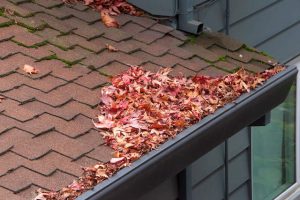
Issues that can lead to water damage from gutters include:
Improper installation
Clogged downspout
Not enough measures in place, like splash guards, to properly channel a high volume of water
Leaks from damaged tubing
Incorrect pitch away from the home
A buildup of leaves and debris in the gutter
Inadequate draining channel for the downspout
Misalignment from heavy storms
In short, there are a lot of issues that can pop up and result in water damage from gutters in your home. With proper maintenance and installation, however, many moisture-related incidences and the issues they cause can be avoided.
Why is Water Damage From Gutters a Big Deal?
The hefty bill from fixing structural issues caused by water damage is probably one of the top concerns many homeowners consider. With good cause because those prices can add up depending on whether major foundational issues need to be resolved, if the roof needs to be fixed, or if windows and the surrounding materials require replacing.
Another main issue of water damage in a home is the ability of mold to move in. And, where mold is found, other indoor contaminants like bacteria can also tag along for the party. Once these establish in a home, the space will become a contaminated environment that does not support the health and wellbeing of those living inside.
The Mold and Water Damage Love Affair (and why it relates to you)
There are over 100,000 species of mold identified so far. Once this fungus colonizes a surface, it releases microscopic particles called spores into the surrounding area.¹’² Like the seeds of a plant, these spores are non-living particles until they’re given the components needed to begin growing.
Thanks to their super hardy nature, spores typically only need two major things to turn into a living organism: food and moisture.³ If these two components exist on a surface for 24-48 hours, there's an opportunity for mold growth to occur.
Water damage from gutters offers the perfect opportunity for this to occur in your home. All that’s left is a food source, and a majority of what’s in a home offers the perfect opportunity. Materials can include wood, glue, carpet, wallpaper, and a long list of other organic matter. Before you know it, that mold spore will put down roots called hyphae and transition into a thriving colony.
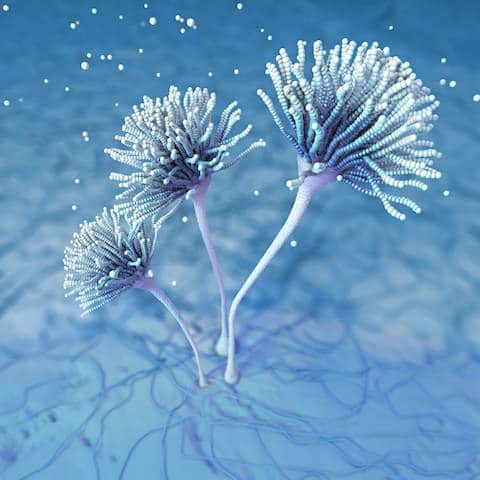
The issue with indoor mold is that as the colony is growing, it’s releasing more and more spores into that indoor space. Some species of mold can also create microscopic toxins called mycotoxins into the surrounding space as well.⁴ Thanks to modern building practices pushing for net-zero energy efficiency, a majority of these tiny particles remain trapped within that indoor space.
This results in:
Poor indoor air quality
Contaminated surfaces
Increased chances of another mold colony developing elsewhere in the home
The longer that colony exists, the more particles will build up in that indoor space. Again, bacteria can also be present as well, adding to the particulate matter inside. This level of contamination can wreak havoc on the health of those exposed and trigger a wide range of chronic symptoms and related health conditions.
The Health Impact
The ability for these contaminants to impact health largely rests on their size. Measured in a unit called microns, mold particles, bacteria, and mycotoxins are so small that they’re able to make their way into our bodies through inhalation, absorption, and ingestion.⁵ The EPA classifies these types of particles as particulate matter and further breaks them down into two categories.⁶
These two categories are:
- PM10: particles that have a diameter of around 10 micrometers or less.
- PM2.5: fine particles that have a diameter of around 2.5 micrometers or less.
As the microscopic particles make their way into the body, the body tags them as foreign invaders and deploys the immune system to get rid of them ASAP. The tricky thing, though, is that no two people react similarly to exposure. While one individual with water damage from gutters may develop a few random symptoms, another may develop over 30 reactions as well as related autoimmune conditions such as Chronic Fatigue Syndrome or Lyme disease.
One of the main reasons for the ambiguity surrounding mold’s effect on the body is the lack of research dedicated to this indoor contaminant.⁷’⁸’⁹’¹⁰’¹¹ A long list of factors can play a role in what adverse health reactions are experienced, highlighting the need for a much closer look at this fungus among us.
These factors include:
- Presence of mycotoxins
- Presence of bacteria
- Immune system status (compromised and developing immune systems don’t handle exposure as well)
- Length of exposure
- Volume of exposure
- Species of mold
- Genetics
These all combine and result in a sort of Russian roulette of if and to what extent someone will react to exposure.

Some of the most common symptoms of exposure include:
- Chronic fatigue
- Hair loss
- Brain fog
- Hormonal imbalances
- Mood swings
- Anxiety and/or depression
- Rashes
- Digestive problems
- Coughing
- Sinus issues
The ability of these indoor contaminants to cause our bodies harm is why it’s important to understand how to prevent water damage from gutters from occurring.
How to Prevent Water Damage From Gutters From Happening
The best way to avoid mold is to stop it from occurring in the first place. That includes actions such as actively working on avoiding water damage from gutters through proper installation and maintaining a streamlined channeling system.
How to Properly Install Gutters
Whether you’re about to have gutters installed or want to make sure that the ones you already have are correctly in place, here’s what you need to know.
When installed correctly, your gutters should:
Have about a quarter of an inch of pitch or slant for every 10 feet of gutter. More than this can result in a sloshing effect during heavy rains that could overload the end of the gutter that’s connected to the downspout. Too little of a pitch/slant can lead to water either sitting in the gutter or overflowing because it can't get to the downspout/leader quick enough.
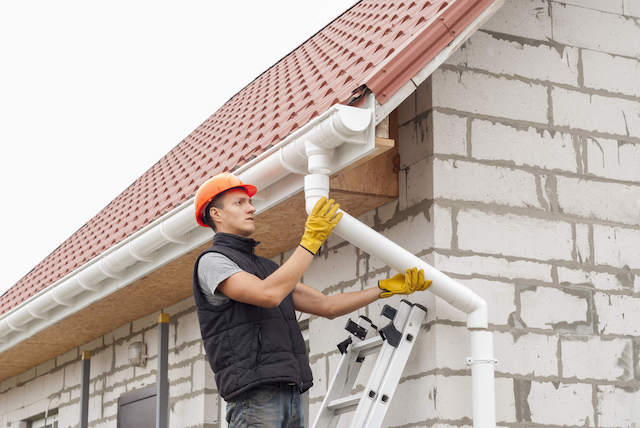
Be fastened to the home directly to the facia board, which is a long board on the home that connects to the roof rafters and walls of the attic, and is the mount for the gutters. The fastening should take place about every 16 to 24 inches and can be secured with a nail, screw, or more progressive fastening technique. It should secure the gutter to the roof system in between the shingle and the sheathing of the roof. Whether asphalt-based, cedar, or slate, the shingles should extend into the gutter approximately half an inch. The most you'd want your roof system to extend into the gutter is approximately two inches. Any more than that and the water load from the roof can overrun the gutter during heavy rain and end up spilling onto the ground line outside of your home.
Have properly installed downspouts/leaders. There should be a small hole, about an inch and a half to two inches at one or both ends of a gutter system. The leader has two different ends to every connection. It has what's known as a bell, the larger end of the connection, and the spigot, the smaller end of the connection. Starting at the top, the leader system should always be installed with the spigot fitting snugly into the bell end of a connection and work its way down. When installed improperly, water can spill down the exterior surface of the leader and terminate directly onto the ground not being directed correctly away from the home. again potentially affecting the subterranean areas of the structure.
Have downspouts/leaders that terminate correctly. When terminated correctly at the ground, the lower stopping point should be approximately 6 to 12 inches above the exterior grade of your home. Once terminated at the correct height, gutter extensions should be used to direct water approximately four feet away from the home. If the ground type or exterior topography does not allow proper drainage away from the home, it's a good idea to extend the bottom of your leaders approximately eight to 10 feet away from the footing and foundation of the structure. That way, water won’t run back towards the basement or crawlspace of the subterranean area.
Ticking off each of these boxes will help avoid any mishaps that lead to water damage from gutters occurring in your home.
Gutter Maintenance
Installation is the first line of defense in ensuring those moisture removers are doing their job and protecting the interior of the home. Continued maintenance after installation is the next step in safeguarding these channeling devices and making sure water damage from gutters doesn’t occur.
There are several steps homeowners can take throughout the year to make sure their gutters are in tip-top shape.
Preventative steps include:
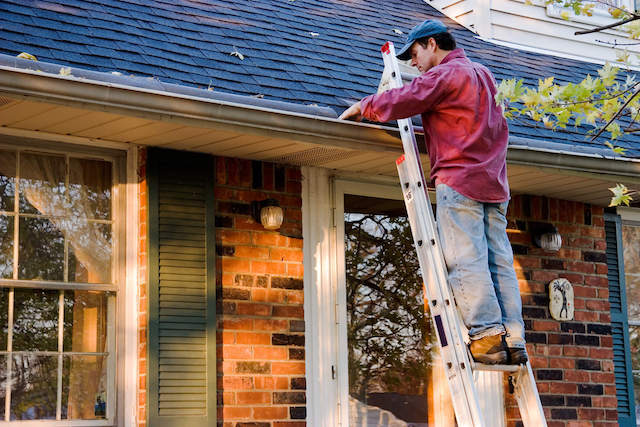
Setting a cleaning schedule: Homeowners can either clean the gutters by themselves or hire a company to come in and remove any built-up debris like leaves and twigs. Twice a year minimum should be the goal, but the more often the better, particularly for homes near lots of trees. Built-up debris can lead to clogged gutters that don’t properly move water away from the home.
Replacing them as needed: Whether a big storm hit and sent that tubing through the wringer or they’ve just reached the end of their shelf life, replacing gutters on time can avoid leaks and other problems that can lead to water damage inside of the home.
Routinely checking for downspout clogging: If the downspout/leader is clogged, all of that water making its way down will not be able to travel down the tubing and away from the home. Instead, it will overflow and potentially make its way inside the home.
Investing in the gutter and/or splash guards: These prevent leaves and debris from making their way inside the gutter and help slow down the water during heavy rains so it moves correctly throughout the gutter system.
Inspect them often: Pop out frequently to take a close look at the gutters. Check for any leaks, sagging, debris buildup, cracks, or anything else that needs to be resolved by either you or a professional. Make sure to pay attention to the slope of the gutters as well to make sure they can properly channel any incoming water. The sooner you catch a problem, the less chance of water damage from gutters occurring.
Collectively, these steps will help decrease the chances that water damage from gutters doesn’t happen to your property.
It’s the Little Things

Gutters and mold probably aren’t at the top of many people’s list of concerns, but they should be! No one wants to live in a home that’s filled with contaminants or structural issues. That’s why building awareness is so important.
The more you know about maintaining a healthy indoor environment, the safer you and your family will be. Taking action to avoid water damage from gutters is an excellent task to add to your home maintenance routine to keep your indoor space in tip-top shape. Little steps such as this will all add up to money saved and health maintained.
Still Have Questions?
A member of our team is here to help! Click on “Get Started ➤” below to book a consultation with a member of the HOMECLEANSE team. We have a few quick questions that will help us put together a roadmap to solve or prevent all of your mold problems.
Two minutes of your time could lead to better health for you and your family.
- Environmental Protection Agency. (n.d.). Mold. EPA. Retrieved from https://www.epa.gov/mold.
- Centers for Disease Control and Prevention. Basic facts about mold and dampness. Centers for Disease Control and Prevention. Retrieved from https://www.cdc.gov/mold/faqs.htm.
- Lstiburek, J., Brennan, T., & Yost, N. (2002, January 15). Rr-0208: What you need to know about mold. Building Science Corporation. Retrieved from, https://www.buildingscience.com/documents/reports/rr-0208-what-you-need-to-know-about-mold/view.
- World Health Organization. (n.d.). Mycotoxins. World Health Organization. Retrieved from https://www.who.int/news-room/fact-sheets/detail/mycotoxins.
- Environmental Protection Agency. (n.d.). What does mold smell like? EPA. Retrieved from https://www.epa.gov/mold/what-does-mold-smell.
- Nchh. (n.d.). Mold. NCHH. Retrieved from https://nchh.org/information-and-evidence/learn-about-healthy-housing/health-hazards-prevention-and-solutions/mold/
- Curtis, L., Lieberman, A., Stark, M., Rea, W., & Vetter, M. (2004). Adverse health effects of indoor molds. Journal of Nutritional & Environmental Medicine, 14(3), 261-274.
- Bush, R. K., Portnoy, J. M., Saxon, A., Terr, A. I., & Wood, R. A. (2006). The medical effects of mold exposure. Journal of Allergy and Clinical Immunology, 117(2), 326-333
- Fisk, W. J., Lei-Gomez, Q., & Mendell, M. J. (2007). Meta-analyses of the associations of respiratory health effects with dampness and mold in homes. Indoor air, 17(4), 284-296.
- Wild, C. P., & Gong, Y. Y. (2010). Mycotoxins and human disease: a largely ignored global health issue. Carcinogenesis, 31(1), 71-82.
- Environmental and Occupational Health Assessment Program, & Environmental and Occupational Health Assessment Program, & Health Science Section, Mold Basics for Primary Care Clinicians (2009). Hartford, CT; Connecticut Department of Public Health. , H. S. S., Mold Basics for Primary Care Clinicians 1–10 (2009). Hartford, CT; Connecticut Department of Public Health.
- Chauhan, B., Santiago, L., Kirschmann, D. A., Hauptfeld, V., Knutsen, A. P., Hutcheson, P. S., … & Bellone, C. J. (1997). The association of HLA-DR alleles and T cell activation with allergic bronchopulmonary aspergillosis. The Journal of Immunology, 159(8), 4072-4076.
Chicago - Knutsen, A. P., Vijay, H. M., Kumar, V., Kariuki, B., Santiago, L. A., Graff, R., … & Shah, M. R. (2010). Mold‐sensitivity in children with moderate‐severe asthma is associated with HLA‐DR and HLA‐DQ. Allergy, 65(11), 1367-1375.
Chicago - EPA. (n.d.). A Brief Guide to Mold, Moisture, and Your Home. EPA. Retrieved from https://www.epa.gov/mold/brief-guide-mold-moisture-and-your-home#tab-6.
Must-Have Indoor Air Quality Tools
-

EC3 Laundry Additive
Add EC3 to every rinse cycle to rinse away mold, bacteria and musty odors from...
-
$23.00 Shop Now -

Intellipure Compact Air Purifier
Small in size, but delivers powerful results, reducing airborne microorganisms like mold, viruses, and bacteria.
-
$649.00 Shop Now -

Intellipure SuperV Whole House Air Purifier
Turn your HVAC into a filtration system, removing 99% of ultrafine particles including airborne mold,...
-
Price range: $2,000.00 through $2,995.00 Shop Now -

HomeCleanse Cleaning
Take your cleaning to the next level buying all the tools we use to keep...
-
Price range: $299.00 through $549.00 Shop Now -

Mold & Bacteria Contents Cleaning
Remove harmful pollutants that accumulate in the dust of your home. (Options available for renters...
-
Price range: $99.00 through $349.00 Shop Now -

EC3 Mold Solution Concentrate
Micro Balance EC3 Mold Solution Concentrate is a natural botanical that removes mold spores, bacteria,...
-
$33.00 Shop Now -

Industry-Leading Intellipure Ultrafine 468
The Intellipure® Ultrafine 468 features our proprietary DFS technology, which traps and eliminates potentially harmful...
-
Shop Now -

The Dust Test
The Dust Test is a comprehensive at-home test that helps you identify mold and toxins...
-
$299.00 Shop Now -

EuroClean 4 Gallon Hepa Vacuum
The Euroclean GD930HSP is a 4 Gallon Dry HEPA Vacuum that meets the EPA's standards...
-
$849.00 Shop Now -

AprilAire E080 Professional Dehumidifier Bundle
Includes all the dehumidifier accessories you will need. Our Aprilaire E080 comes with a drain...
-
$1,524.99 Shop Now
